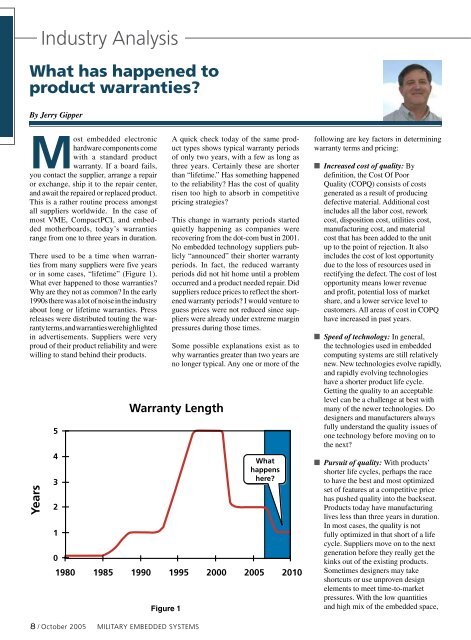Military Embedded Systems - Fall 2005 - Volume 1 Number 2
Military Embedded Systems - Fall 2005 - Volume 1 Number 2
Military Embedded Systems - Fall 2005 - Volume 1 Number 2
Create successful ePaper yourself
Turn your PDF publications into a flip-book with our unique Google optimized e-Paper software.
Industry Analysis<br />
What has happened to<br />
product warranties?<br />
By Jerry Gipper<br />
Most embedded electronic<br />
hardware components come<br />
with a standard product<br />
warranty. If a board fails,<br />
you contact the supplier, arrange a repair<br />
or exchange, ship it to the repair center,<br />
and await the repaired or replaced product.<br />
This is a rather routine process amongst<br />
all suppliers worldwide. In the case of<br />
most VME, CompactPCI, and embedded<br />
motherboards, today’s warranties<br />
range from one to three years in duration.<br />
There used to be a time when warranties<br />
from many suppliers were five years<br />
or in some cases, “lifetime” (Figure 1).<br />
What ever happened to those warranties?<br />
Why are they not as common? In the early<br />
1990s there was a lot of noise in the industry<br />
about long or lifetime warranties. Press<br />
releases were distributed touting the warranty<br />
terms, and warranties were highlighted<br />
in advertisements. Suppliers were very<br />
proud of their product reliability and were<br />
willing to stand behind their products.<br />
Years<br />
5<br />
4<br />
3<br />
2<br />
1<br />
0<br />
A quick check today of the same product<br />
types shows typical warranty periods<br />
of only two years, with a few as long as<br />
three years. Certainly these are shorter<br />
than “lifetime.” Has something happened<br />
to the reliability? Has the cost of quality<br />
risen too high to absorb in competitive<br />
pricing strategies?<br />
This change in warranty periods started<br />
quietly happening as companies were<br />
recovering from the dot-com bust in 2001.<br />
No embedded technology suppliers publicly<br />
“announced” their shorter warranty<br />
periods. In fact, the reduced warranty<br />
periods did not hit home until a problem<br />
occurred and a product needed repair. Did<br />
suppliers reduce prices to reflect the shortened<br />
warranty periods? I would venture to<br />
guess prices were not reduced since suppliers<br />
were already under extreme margin<br />
pressures during those times.<br />
Some possible explanations exist as to<br />
why warranties greater than two years are<br />
no longer typical. Any one or more of the<br />
Warranty Length<br />
What<br />
happens<br />
here?<br />
1980 1985 1990 1995 2000 <strong>2005</strong> 2010<br />
Figure 1<br />
following are key factors in determining<br />
warranty terms and pricing:<br />
n<br />
n<br />
n<br />
Increased cost of quality: By<br />
definition, the Cost Of Poor<br />
Quality (COPQ) consists of costs<br />
generated as a result of producing<br />
defective material. Additional cost<br />
includes all the labor cost, rework<br />
cost, disposition cost, utilities cost,<br />
manufacturing cost, and material<br />
cost that has been added to the unit<br />
up to the point of rejection. It also<br />
includes the cost of lost opportunity<br />
due to the loss of resources used in<br />
rectifying the defect. The cost of lost<br />
opportunity means lower revenue<br />
and profit, potential loss of market<br />
share, and a lower service level to<br />
customers. All areas of cost in COPQ<br />
have increased in past years.<br />
Speed of technology: In general,<br />
the technologies used in embedded<br />
computing systems are still relatively<br />
new. New technologies evolve rapidly,<br />
and rapidly evolving technologies<br />
have a shorter product life cycle.<br />
Getting the quality to an acceptable<br />
level can be a challenge at best with<br />
many of the newer technologies. Do<br />
designers and manufacturers always<br />
fully understand the quality issues of<br />
one technology before moving on to<br />
the next?<br />
Pursuit of quality: With products’<br />
shorter life cycles, perhaps the race<br />
to have the best and most optimized<br />
set of features at a competitive price<br />
has pushed quality into the backseat.<br />
Products today have manufacturing<br />
lives less than three years in duration.<br />
In most cases, the quality is not<br />
fully optimized in that short of a life<br />
cycle. Suppliers move on to the next<br />
generation before they really get the<br />
kinks out of the existing products.<br />
Sometimes designers may take<br />
shortcuts or use unproven design<br />
elements to meet time-to-market<br />
pressures. With the low quantities<br />
and high mix of the embedded space,<br />
/ October <strong>2005</strong><br />
<strong>Military</strong> EMBEDDED SYSTEMS
















